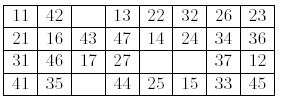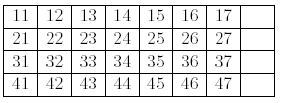hdu1067 N - Gap
来源:互联网 发布:多个相同表格数据提取 编辑:程序博客网 时间:2024/04/30 09:45
HomeProblemsStatusContest[ak1]Logout
FAQ | About Virtual Judge | Forum | Discuss | Open Source Project
All Copyright Reserved ©2010-2012 HUST ACM/ICPC TEAM
Anything about the OJ, please ask in the forum, or contact author:Isun
Server Time:
277:06:36
307:00:00
FAQ | About Virtual Judge | Forum | Discuss | Open Source Project
All Copyright Reserved ©2010-2012 HUST ACM/ICPC TEAM
Anything about the OJ, please ask in the forum, or contact author:Isun
Server Time:
- hdu1067 N - Gap
- HDU1067 Gap
- HDU1067 Gap 【BFS+MAP】
- hdu1067 Gap (bfs+hash)
- hdu1067 Gap----BFS+哈希
- hdu1067
- HDU1067 Gap( BFS+ HASH 剪枝,矩阵用一个数表示)
- hdu1067 bfs
- LeetCode Maximum Gap的O(N)解法
- Gap
- GAP
- Generation Gap
- GAP Analysis
- 4479. Gap
- Phone Gap
- UNRESOLVABLE GAP
- Prime Gap
- Prime Gap
- 使用mybatis执行oracle存储过程
- 新的开始之 CentOS 修改Root密码
- experiment : 使用OD 调试带启动参数的程序
- 房租分配问题
- 回滚段与撤销段的区别
- hdu1067 N - Gap
- POJ2752_Seek the Name, Seek the Fame_KMP_对next数组的运用
- 教你用ajax来初始化一个zTree
- 项目中 session 找不到
- Android实现ListView异步加载图片
- 解决 eclipse ADB server didn't ACK问题
- 什么是Core Dump?
- 移植对话框资源
- 情绪





